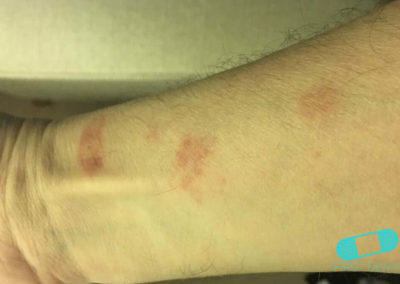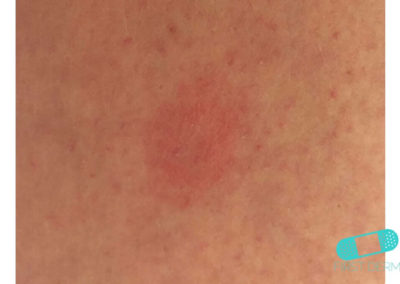Nummular Eczema (Discoid Dermatitis)
Medically reviewed by The Dermatologists and written by Dr. Alexander Börve
Common
More than 200,000 US cases per year
- Requires medical diagnosis
- Symptoms: Coin-shaped eczema, well-defined round or oval lesion
- Color: Typically pink, red or brown
- Location: Often on the legs, sometimes on the torso, arms, hands, and feet
- Treatment: Corticosteroid ointments and tar creams
ICD-10: L30.0
ICD-9: 692.9
Nummular (meaning round or “coin shaped”) eczema is an inflammatory skin condition characterized by well-defined round or oval lesion. It tends to appear after a skin injury, such as a burn, abrasion (from friction) or insect bite.
This condition tends to be chronic, and its cause remains unknown. However, nummular eczema is most common among people with a history of allergies, asthma or atopic dermatitis.
In addition, men get nummular dermatitis more often than women get it. Men often have their first outbreak between 55 and 65 years of age. When women get it, they are usually younger. They tend to be teenagers or young adults
Symptoms of Nummular Eczema
Nummular eczema appears as a group of tiny reddish spots and fluid-filled sores, which forms into a coin-shaped patch. These patches range in size from smaller than 1 inch to bigger than 4 inches. They are often pink, red or brown. The skin between the patches often remains clear, but it can be dry and easily irritated.
These patches often occur on the legs, but sometimes also on the torso, arms, hands, and feet. They can itch and burn, especially at night. After the blisters leak fluid, the patch may become crusty and scaly.
What can I do?
A skin injury can worsen your skin condition, so you should protect your skin from getting scraped, cut or injured in any other way. To hydrate your skin, you can:
- Take a 20-minute lukewarm bath or shower once a day
- Apply non-scented moisturizer at least once a day after bathing
- Use a mild, gentle cleanser instead of soap
- Avoid activities that dries, heats or irritates your skin (e.g. sitting next to a fire or heater)
- Use a humidifier to add moisture to the air, especially when you heat or air-condition your home
- Wear loose clothing and soft fabrics, but do not use fabric softener and dryer sheets
- Avoid stress
- Avoid exposure to environmental irritants, such as household cleaners and chemicals
You can also take antihistamines to relieve itching and discomfort and use moist bandages to cover and protect the affected areas.
Should I seek medical care?
A yellowish crust may develop on the patches if a Staphylococcus aureus (staph) infection occurs. This may require treatment with an antibiotic. It is recommended that you see a dermatologist.
Treatment for Nummular Eczema
Corticosteroid ointments and tar creams are often prescribed to reduce inflammation and itch. Your dermatologist may swab the sores if the doctor thinks you have a skin infection. If a bacterial skin infection occurs, your dermatologist will prescribe an antibiotic. Your dermatologist may recommend patch testing to find allergies if the treatment does not fully clear your skin. An allergy can prevent the skin from clearing. In severe cases, you may need stronger corticosteroids, medicated dressings or phototherapy (treatment with light). Sores on the thighs, legs, and feet often take longer to heal and tend to leave behind darker or lighter spots.
Source:
Jami L Miller, MD. Nummular Dermatitis. Available at: http://emedicine.medscape.com/article/1123605-overview
American Academy of Dermatology. Nummular dermatitis. Available at: https://www.aad.org/public/diseases/eczema/nummular-dermatitis
Amber Erickson Gabbey. Nummular Eczema. Available at: http://www.healthline.com/health/skin/nummular-eczema
Ask a Dermatologist Now
Anonymous, fast and secure!

The Specialist doctor from the University Hospital in Gothenburg, alumnus UC Berkeley. My doctoral dissertation is about Digital Health and I have published 5 scientific articles in teledermatology and artificial intelligence and others.
![Nummular Eczema leg (Discoid Dermatitis) (15) leg [ICD-10 L30.0]](https://www.firstderm.com/wp-content/uploads/Nummular-Eczema-Discoid-Dermatitis-15-leg-ICD-10-L30.0-400x284.jpg)

![Nummular Eczema (Discoid Dermatitis) (18) leg [ICD-10 L30.0]](https://www.firstderm.com/wp-content/uploads/Nummular-Eczema-Discoid-Dermatitis-18-leg-ICD-10-L30.0-400x284.jpg)
![Nummular Eczema (Discoid Dermatitis) (20) skin ICD-10 L30.0]](https://www.firstderm.com/wp-content/uploads/Nummular-Eczema-Discoid-Dermatitis-20-skin-ICD-10-L30.0-400x284.jpg)
![Nummular Eczema (Discoid Dermatitis) (17) arm [ICD-10 L30.0]](https://www.firstderm.com/wp-content/uploads/Nummular-Eczema-Discoid-Dermatitis-17-arm-ICD-10-L30.0-400x284.jpg)
![Nummular Eczema (Discoid Dermatitis) (23) skin [ICD-10 L30.0]](https://www.firstderm.com/wp-content/uploads/Nummular-Eczema-Discoid-Dermatitis-23-skin-ICD-10-L30.0-400x284.jpg)
![Nummular Eczema (Discoid Dermatitis) (16) skin [ICD-10 L30.0]](https://www.firstderm.com/wp-content/uploads/Nummular-Eczema-Discoid-Dermatitis-16-skin-ICD-10-L30.0-400x284.jpg)

![Nummular Eczema (Discoid Dermatitis) (14) skin [ICD-10 L30.0]](https://www.firstderm.com/wp-content/uploads/Nummular-Eczema-Discoid-Dermatitis-14-skin-ICD-10-L30.0-400x284.jpg)
![Nummular Eczema (Discoid Dermatitis) (13) skin [ICD-10 L30.0]](https://www.firstderm.com/wp-content/uploads/Nummular-Eczema-Discoid-Dermatitis-13-skin-ICD-10-L30.0-400x284.jpg)
![Nummular Eczema (Discoid Dermatitis) (19) skin [ICD-10 L30.0]](https://www.firstderm.com/wp-content/uploads/Nummular-Eczema-Discoid-Dermatitis-19-skin-ICD-10-L30.0-400x284.jpg)
![Nummular Eczema (Discoid Dermatitis) (10) arm [ICD-10 L30.0]](https://www.firstderm.com/wp-content/uploads/Nummular-Eczema-Discoid-Dermatitis-10-arm-ICD-10-L30.0-400x284.jpg)
![Nummular Eczema (Discoid Dermatitis) (21) skin [ICD-10 L30.0]](https://www.firstderm.com/wp-content/uploads/Nummular-Eczema-Discoid-Dermatitis-21-skin-ICD-10-L30.0-400x284.jpg)

